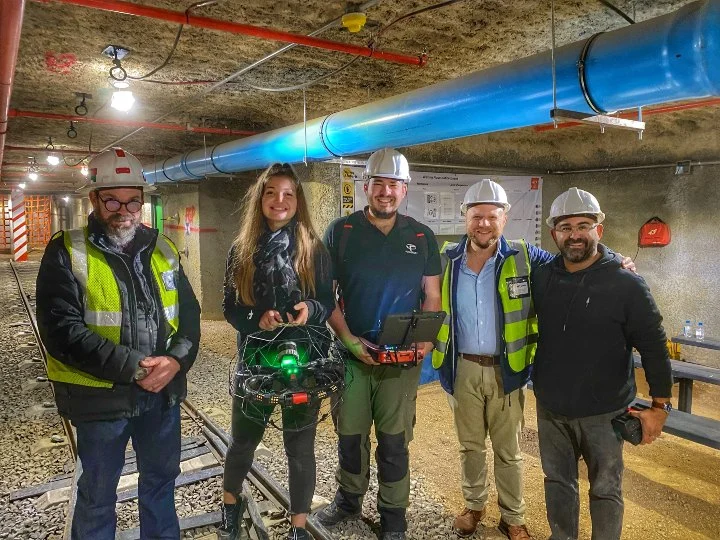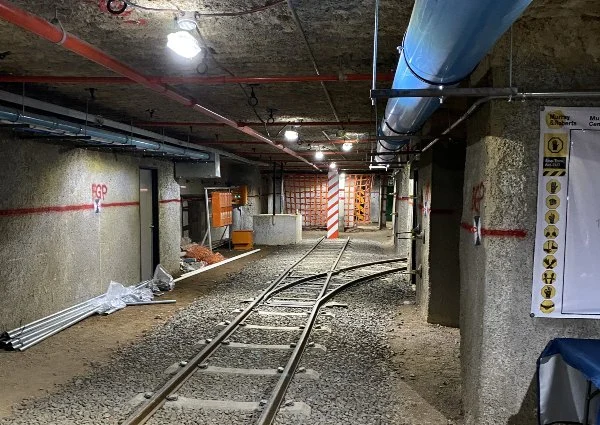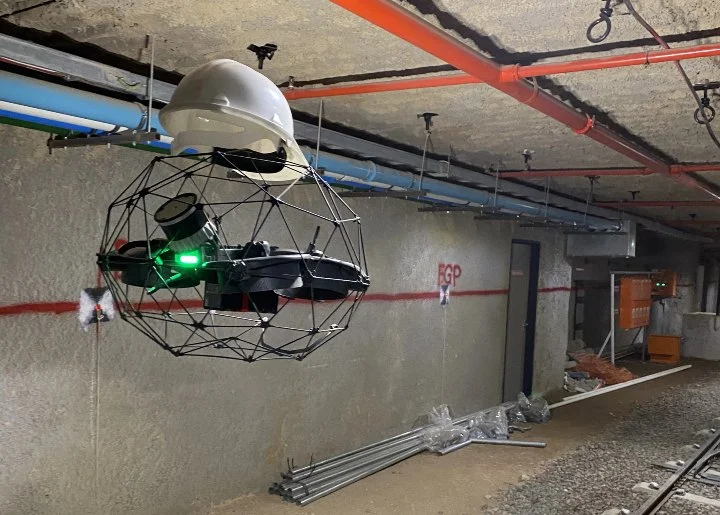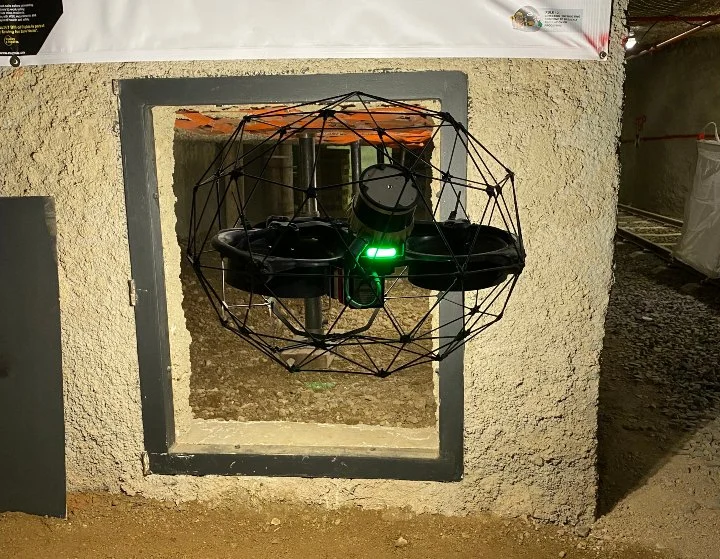In this interview, we speak with Associate Professor Grobler about the growing use of drones in South Africa's mining industry. From enhancing safety to improving data collection and operational efficiency, drones are playing an increasingly vital role in modern mining operations. I graduated in 1991 with a mine surveying qualification from the Department of Mining Engineering and Mine Surveying at the University of Johannesburg. As is common in South Africa, those working in mining must also obtain a Government Certificate of Competency. I earned mine certification in 1994 and spent the next thirteen years working in gold, nickel, and platinum mines. In 2007, I transitioned into academia and began teaching at the same department where I had once studied. It's been rewarding to pass on my knowledge and help shape the next generation of mining professionals. Associate Professor Grobler with representatives from Flyability and GammaTec The Mining Engineering and Mine Surveying Department will turn 100 in 2026, so we’ve been around for quite some time. We offer bachelor’s degrees in both mining engineering and mine surveying, as well as honors and master’s programs. Each year, we train around 600 students across our four degree programs. Employability is a big focus for us. Many of our students are already working in the mines before they start their studies, or they move directly into the industry after graduation. A few years ago, we built a tunnel on campus that functions as a simulation mine. We used an existing basement with a shaft to create a realistic underground layout—this is a rare facility, as only a few such simulation mines exist worldwide. This tunnel is used for hands-on training, allowing students to gain practical experience without having to visit actual mines daily. A picture of the simulation mine We also use the tunnel to test new technologies like drones and robots. For instance, we've operated the Boston Dynamics Spot robot and Flyability’s Elios 3 inside it. In addition, we have a virtual reality platform where students can practice drilling and blasting in a safe environment. This helps them develop skills before they ever step into a real mine. Drones are primarily used for surveying and inspections. According to regulations, surface plans need to be updated every three months to a year. Drones make this process much safer and more efficient by reducing the need for personnel to walk through dangerous areas. For underground inspections, drones can collect visual and LiDAR data in unstable areas. This helps identify issues like hangups and improves our understanding of the mine’s structure. Safety and efficiency are two major benefits. Using drones to measure surface volumes saves time and reduces exposure for survey teams. Drones can also access hard-to-reach or unstable areas underground, collecting high-quality data quickly. This data is useful for engineers, geologists, and other professionals involved in the operation. During emergencies, drones can be invaluable. In one tragic case, rescuers died due to extreme heat while searching for a missing person. A drone could have flown into the area, measured temperatures, and assessed the situation remotely before risking human lives. Mining is a huge industry in South Africa, with over half a million people employed. Any technology that helps reduce fatalities is welcomed. Drones have the potential to bring that number down to zero. South Africa has strict drone licensing laws, but some mining companies are operating drones without proper licenses or trained pilots. This can lead to fines or even criminal charges. There’s also a lack of proper training. Just because someone owns a consumer drone doesn’t mean they can use it safely in a mine. We’re working to raise awareness about the importance of compliance and training. The Elios 2 was the first Flyability drone I encountered. Its roll cage design was impressive for collision resistance. However, it needed improvements in stability. With the Elios 3, these issues have been addressed. The drone is incredibly stable—during testing, we placed a hardhat on top of it, and it didn’t budge. The Elios 3 also allows the camera to rotate up and down, which helps identify survey points in tunnels and excavations. The LiDAR on the Elios 3 makes it more than just an inspection tool—it's now a mapping device. It can map inaccessible areas and block caving, providing real-time 3D data of underground spaces. Compared to photogrammetry, LiDAR works in low-light conditions and can penetrate dust and smog. This is especially important in South African mines, where visibility can be extremely limited due to heat and dust. The Elios 3's LiDAR sensor glows green as it flies in the simulation mine LiDAR also helps in creating real-time 3D maps, which is essential for navigation in low-visibility environments. It can detect geological features like faults and dykes, helping identify hazards early. LiDAR is also useful for inspecting ore passes, where obstructions like mud or debris can cause blockages. It provides a clear view of these areas, making inspections faster and safer. We're still in the early stages of drone adoption in South Africa. Some may question whether these technologies are just looking for a purpose, but I believe they are essential for improving safety and efficiency. In fact, I don't think any mine in South Africa is currently operating without some form of drone technology nearby. The next step is to mainstream this technology and encourage wider adoption. Rather than relying on external contractors, each mining company should own at least one drone like the Elios 3. This would allow for better integration and regular use across different operations. Eventually, having a drone on each shaft could enable daily or weekly mapping of mine ends, improving planning and safety significantly. Plasma Metal Polishing Machine Bayi specializes in plasma polishing equipment. We provide efficient polishing equipment to meet your various polishing needs. Plasma polishing machine can complete a large number of metal surface treatment work in a short time. It realizes batch polishing and improves production efficiency for you. After the metal is plasma polished, it has a much smoother surface. It can achieve a smooth, glossy, or mirror effect. We are a China plasma polishing machine manufacturer. Our polishing equipment has a high service life, low failure rate, and low maintenance cost. And it does not produce noise and pollution. We can also according to your polishing needs. We can customize the right plasma polishing solution for you. Contact us to get a favorable plan now. Metal Polishing Machine,Metal Polishing Equipment,Plasma Polishing Machine,metal buffing machine,Metal Surface Polishing Machine Dongguan Bayi Automation Equipment Co., Ltd , https://www.bayipolisher.com
What has been your career path with mining in South Africa?

Tell us about the Mining Engineering and Mine Surveying Department at the University of Johannesburg. What does the department do?Â
What kind of unique training facilities do you have in the department?

How are drones being used in mining?Â
What are the advantages of using a drone in mining?
What are some concerns you have about how people are using drones for work in mines?
How do you think Flyability’s Elios 3 can benefit work in mining?

The Elios 3 carries a LiDAR sensor. What benefits can mining operations realize by using an indoor drone equipped with LiDAR sensing?

What does the future of drones look like for mining operations in South Africa?
Metal Surface Polishing Machine